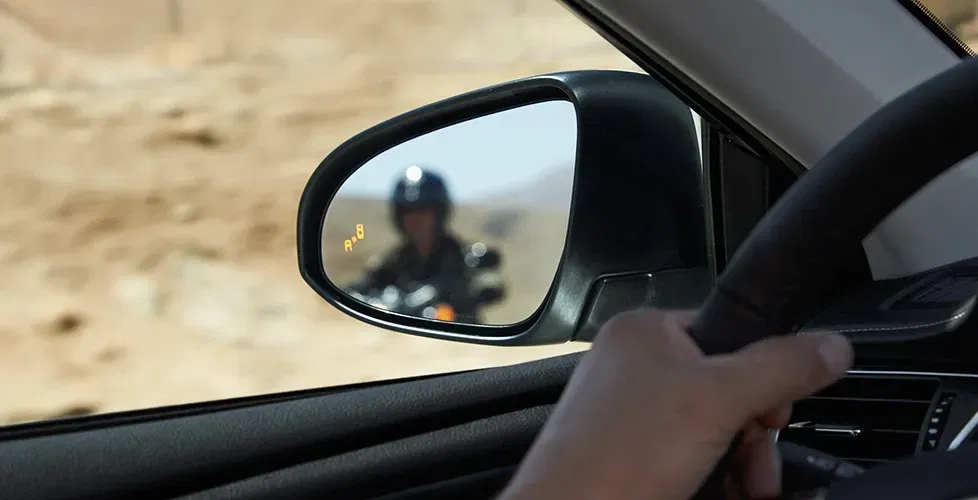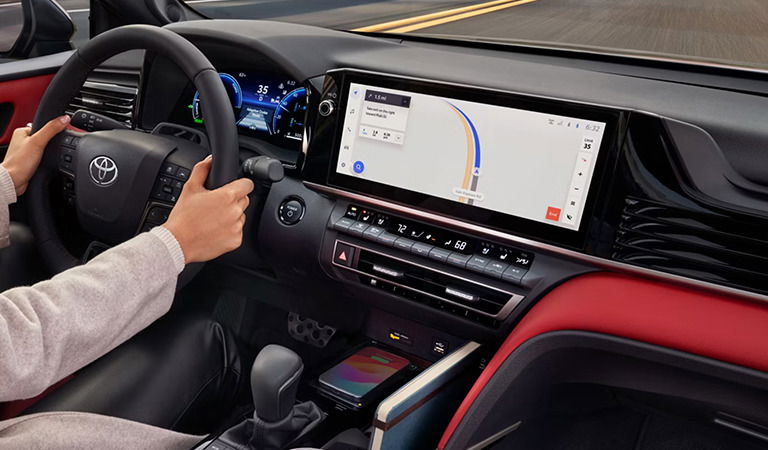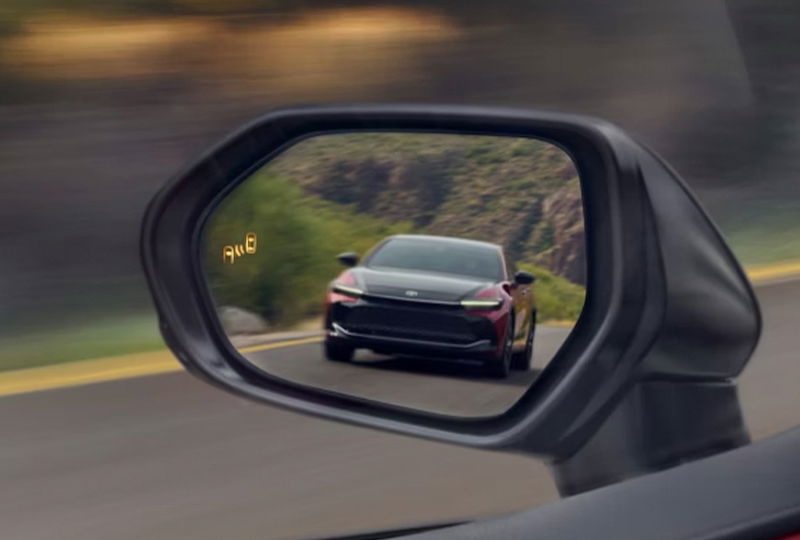Toyota’s mid-size sedan, the Camry, has long been praised for its reliability, comfort, and value. But in an age of increasing driver-assistance technology, buyers are increasingly no longer content with reliability and resale value. They want safety features that protect them and their passengers.
One such feature is the Blind Spot Monitor (BSM), which Toyota has gradually integrated into various Camry trims over the years.
This article dives deep into everything you need to know about the Toyota Camry’s Blind Spot Monitor: how it works, which model years and trims include it, and whether it can be added to Camrys that don’t have it from the factory.
What Is Toyota’s Blind Spot Monitor (BSM)?
The Blind Spot Monitor is a driver-assistance feature that uses radar sensors located near the rear of the vehicle to detect other vehicles in the driver's blind spots. When a vehicle is detected in an adjacent lane, a warning indicator (typically a small light) illuminates on the side mirror on the corresponding side.
Key Functions Of Blind Spot Monitor:
1. Blind Spot Detection:
- Uses radar or ultrasonic sensors to monitor the adjacent lanes (typically on both sides).
- Alerts the driver when a vehicle enters the blind spot zone (usually alongside or slightly behind the Camry).
2. Visual and Audible Warnings:
- Side Mirror Indicator: A small LED light (usually amber) illuminates on the corresponding side mirror when a vehicle is detected.
- Flashing or Beeping Alert: If the turn signal is activated while a vehicle is in the blind spot, the system may flash the light and/or emit a beep to warn the driver.
3. Rear Cross-Traffic Alert (RCTA) (Often Paired with BSM):
- When reversing (e.g., out of a parking spot), the system detects approaching vehicles from the sides and alerts the driver with audible beeps and visual warnings.
4. Adjustable Sensitivity (In Some Models):
- Some Camry trims allow drivers to adjust the sensitivity or turn off BSM via the vehicle’s settings.
5. Works at Highway and City Speeds
- Typically activates at speeds above ~25 mph for blind spot monitoring.
- RCTA works at lower speeds (when reversing).
Benefits Of Adding Blind Spot Monitor In The Toyota Camry
- Helps prevent side-swipe collisions during lane changes.
- Enhances safety when merging on highways or in heavy traffic.
- Works in low-visibility conditions (rain, fog, or at night).
Limitations Of Blind Spot Monitor In Toyota Camry
- May not detect small vehicles (e.g., motorcycles) or fast-approaching cars in time.
- Sensors can be affected by dirt, snow, or heavy rain.
- Driver should still check blind spots manually—BSM is an aid, not a replacement.
Why The Blind Spot Monitor Matters

According to the National Highway Traffic Safety Administration (NHTSA), there were approximately 5.93 million police-reported traffic crashes in the U.S. in 2022, with the University of Pittsburgh's report noting that unsafe lane changes account for about 9% of all U.S. accidents that year, which would translate to roughly 533,000 crashes if that percentage held steady.
Earlier studies, such as a 2003 NHTSA analysis, estimated around 539,000 lane-change crashes annually.
A blind spot monitoring system helps eliminate guesswork by alerting drivers of potential collisions before they occur.
Why Do You Need Toyota’s BSM System?

One key advantage of Toyota Camry’s BSM system is the increased confidence it provides during highway driving. By continuously scanning adjacent lanes for vehicles that may not be visible in the mirrors, the system reduces stress and helps drivers maintain awareness, particularly in heavy traffic or high-speed conditions.
Another major benefit is improved lane-change decision-making. The BSM system’s visual alerts (via side mirror indicators) and optional audible warnings give drivers real-time feedback, allowing them to assess whether a lane change is safe. This minimizes sudden maneuvers or hesitation, leading to smoother and more controlled driving.
Additionally, the BSM system is especially valuable for new or teen drivers who may lack experience in judging blind spots. The added layer of detection helps prevent risky merges and side collisions, fostering safer driving habits. While the system is a powerful aid, Toyota still encourages manual checks to ensure maximum safety.
See also: 👇🏿
When Did Toyota Add Blind Spot Monitoring To The Camry?

Toyota started offering the Blind Spot Monitor as an optional package on select trims of the Camry in the mid-2010s, but its availability and standardization have increased significantly over the years.
Here’s a breakdown by model year and trim:
2025 Toyota Camry (9th Generation – Fully Redesigned)
Standard On All Trims
- LE
- SE
- XLE
- XSE
For 2025, Toyota made the Blind Spot Monitor with Rear Cross-Traffic Alert standard across all Camry models. This aligns with the new Toyota Safety Sense 3.0 suite.
2021–2024 Toyota Camry
Standard on:
- XLE
- XSE
- TRD (with tech package)
Optional on:
- SE (via Convenience or Technology Package)
- LE (via LE Convenience Package)
Note: The LE and SE trims didn’t include BSM as standard but could be upgraded.
2018–2020 Toyota Camry
Standard on:
- XLE
- XSE
Optional on:
- SE
- LE
These model years were among the first to offer BSM more widely, with Toyota beginning to introduce it as part of the Toyota Safety Sense P (TSS-P) platform.
2015–2017 Toyota Camry
Limited Availability
- Blind Spot Monitor was only available on higher trims like the XLE and XSE, usually bundled with packages such as the Technology Package or Advanced Technology Package.
2012–2014 Toyota Camry
Rarely Available
- Some V6 XLE models had BSM as part of a premium technology bundle, but it was far from common.
How To Tell If Your Toyota Camry Has A Blind Spot Monitor

If you’re unsure whether your Camry is equipped with BSM, here are a few ways to find out:
- Look at the Side Mirrors: You’ll see a small icon (usually a car with waves or a triangle) etched into the outer corner of the mirror.
- Check the Infotainment System: Many Camrys allow you to toggle the BSM on or off through the vehicle settings menu.
- Owner’s Manual: Consult the manual under the "Driving Assist Systems" section.
- VIN Lookup: Run your Vehicle Identification Number through Toyota’s online lookup tool or a third-party VIN decoder.
Can You Add Blind Spot Monitoring To A Toyota Camry That Doesn’t Have It?
The short answer: It’s possible—but complicated and expensive.

Aftermarket Blind Spot Monitor Installation
While OEM retrofit kits from Toyota are not officially available for older Camry models, aftermarket BSM kits can be installed. These systems typically involve installing radar sensors in the rear bumper, running wiring to the side mirrors or dashboard, and calibrating the system to avoid false positives
Installing an aftermarket blind spot monitor on an older Camry enhances safety and may boost resale value, with customizable alerts to suit preferences.
However, costs range from $500–$1,500, and improper installation risks electrical issues or warranty conflicts. Poor integration with factory systems could also reduce reliability.
For best results, consult a Toyota-certified technician to ensure compatibility and seamless functionality. This upgrade balances modern safety with potential trade-offs in cost and integration.
Which Camry Trim Should You Buy If You Want Blind Spot Monitoring?

If you're shopping for a Toyota Camry and want the Blind Spot Monitor without adding aftermarket parts, here’s a trim-by-trim buying guide:
Best Camry Trims for BSM (Standard Included):
- 2025+ LE, SE, XLE, XSE
- 2021–2024 XLE, XSE, TRD (with package)
- 2018–2020 XLE, XSE
Value Picks:
2021–2024 SE or LE with Convenience or Tech Package
2018–2020 LE/SE with optional upgrades
Avoid These Trims (If You Want BSM Factory-Installed):
- Most L trims
- Base LE/SE trims from 2017 and earlier
Toyota Safety Sense And Blind Spot Monitoring

It’s important to note that Toyota Safety Sense (TSS) includes many features, but BSM is not always part of it. Here’s a quick comparison:
| Feature | Toyota Safety Sense (TSS) | Blind Spot Monitor (BSM) |
| Pre-Collision System | ✅ | ❌ |
| Lane Departure Alert | ✅ | ❌ |
| Dynamic Radar Cruise Control | ✅ | ❌ |
| Blind Spot Detection | ❌ | ✅ |
| Rear Cross Traffic Alert | ❌ | ✅ |
So even if your Camry has Toyota Safety Sense, it doesn’t guarantee it includes BSM, unless specifically noted in the trim features.
Blind Spot Monitor vs. Lane Change Assist: Are They The Same?
Not exactly. While the Blind Spot Monitor alerts you when a vehicle is in your blind zone, Lane Change Assist (LCA) adds extra capability by automatically adjusting steering or issuing more prominent warnings.
As of 2025, the Camry doesn't include LCA in its feature set, but higher-end Toyota models (like the Highlander Platinum or Crown) do.
Will The Blind Spot Monitor Be Standard On Future Camrys?
Based on Toyota's current safety direction and government trends, it's very likely that BSM will remain a standard feature across most, if not all, Camry trims in future model years.
This aligns with Toyota's goal of democratizing safety tech and the broader industry push toward Vision Zero crash-reduction strategies.
Is The Blind Spot Monitor Worth It?

Absolutely, especially for highway drivers, daily commuters, and families. The feature not only increases awareness but also reduces stress in high-traffic scenarios.
If you're buying a new or certified pre-owned Camry, look for the 2018+ XLE or XSE models if you want a balance of safety, value, and comfort.
If you're currently driving a Camry without BSM and wish you could add the feature, consider either upgrading to a newer trim with the feature or installing a reputable aftermarket system.
Toyota Camry Blind Spot Monitor: Key Takeaways
- Blind Spot Monitor (BSM) helps drivers detect vehicles in adjacent lanes.
- Became more widely available starting with the 2018 Camry redesign.
- Standard on all trims from 2025 onward.
- Can be added aftermarket but with caveats.
- Bundled with Rear Cross-Traffic Alert (RCTA) in most cases.
- Best trims to buy for BSM: XLE and XSE (2018+), LE/SE with options, or any 2025+ model.